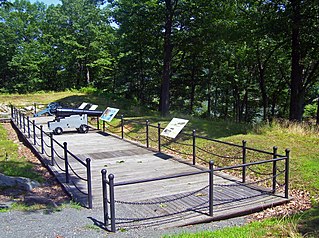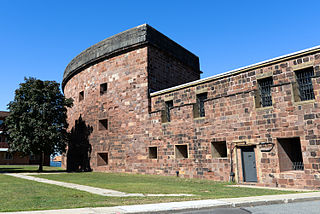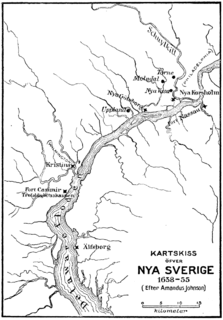
New Amsterdam was a 17th-century Dutch settlement established at the southern tip of Manhattan Island that served as the seat of the colonial government in New Netherland. The factorij became a settlement outside Fort Amsterdam. The fort was situated on the strategic southern tip of the island of Manhattan and was meant to defend the fur trade operations of the Dutch West India Company in the North River. In 1624, it became a provincial extension of the Dutch Republic and was designated as the capital of the province in 1625.

Fort Montgomery is a fortification built on the west bank of the Hudson River in Highlands, New York by the Continental Army during the American Revolution. Erected in 1776, Fort Montgomery was one of the first major investments by the Americans in strategic construction projects.

Liberty Island is a federally owned island in Upper New York Bay in the United States. Its most notable feature is the Statue of Liberty, a large statue by Frédéric Auguste Bartholdi that was dedicated in 1886. Long known as Bedloe's Island, it was renamed by an act of the United States Congress in 1956. Part of New York State, the island is an exclave of the New York City borough of Manhattan, surrounded by the waters of Jersey City, New Jersey.

Fort Amsterdam was a fort on the southern tip of Manhattan at the confluence of the Hudson and East rivers. It was the administrative headquarters for the Dutch and then English/British rule of the colony of New Netherland and subsequently the Province of New York from 1625 or 1626, until being torn down in 1790 after the American Revolution. It was the nucleus of the settlement in the area that became New Amsterdam and eventually New York City.

Governors Island National Monument, a unit of the United States national park system, is located in New York City on 22 acres (89,000 m2) of Governors Island, a 172-acre (0.70 km2) island located off the southern tip of Manhattan Island at the confluence of the Hudson and East Rivers in New York Harbor.

The Hudson River Chain was two chain booms and two chevaux de frise constructed from 1776 to 1778 during the American Revolutionary War across the Hudson River as defenses to prevent British naval vessels from sailing upriver. These defenses along the Hudson River were overseen by the Highlands Department of the Continental Army. The most significant and successful was the Great Chain, constructed from West Point in 1778, and used through 1782 after the war's end. The huge links for the chains were forged at iron works in Orange County, New York.

Fort Clinton was an American Revolutionary War fort erected by the Continental Army on the west bank of the Hudson River in 1776.

Fort Jay is a coastal star fort and the name of a former United States Army post on Governors Island in New York Harbor, within New York City. Fort Jay is the oldest existing defensive structure on the island, and was named for John Jay, a member of the Federalist Party, New York governor, Chief Justice of the Supreme Court, Secretary of State, and one of the founding fathers of the United States. It was built in 1794 to defend Upper New York Bay, but has served other purposes. From 1806 to 1904 it was named Fort Columbus, presumably for explorer Christopher Columbus. Today, the National Park Service administers Fort Jay and Castle Williams as the Governors Island National Monument.

Fort Lee Historic Park is located atop a bluff of the Hudson Palisades overlooking Burdett's Landing, known as Mount Constitution, in Fort Lee, New Jersey. Native Americans appear to have lived in the area for thousands of years before the arrival of Europeans. Site of George Washington's 1776 encampment opposite Fort Washington at the northern end of Manhattan. Fort Lee is named for General Charles Lee. The site is a reconstruction of the encampment including the blockhouse, battery, quarters as well as a visitors center. It is part of Palisades Interstate Park.

The Battle of Fort Washington was a pre-organized, pitched battle fought in New York on November 16, 1776 during the American Revolutionary War between the United States and Great Britain. It was a British victory that gained the surrender of the remnant of the garrison of Fort Washington near the north end of Manhattan Island. It was one of the worst Patriot defeats of the war.
Fort Nassau was the first Dutch settlement in North America, located beside the "North River" within present-day Albany, New York, in the United States. The factorij was a small fortification which served as a trading post and warehouse.

Fort Washington was a fortified position near the north end of Manhattan Island, at the island's highest point, within the modern-day neighborhood of Washington Heights, Manhattan, New York City. The Fort Washington Site is listed on the National Register of Historic Places.

Blockhouse No. 1, colloquially known as The Blockhouse, is a small fort in the North Woods section of Central Park, Manhattan, New York City. Finished in 1814, the Blockhouse is the second oldest structure in the park, after Cleopatra's Needle, and the oldest surviving structure originally built within the park site. It is located on an overlook of Manhattan schist, with a clear view of the flat surrounding areas north of Central Park.

Fort Nassau was a factorij in New Netherland between 1627–1651 located at the mouth of Big Timber Creek at its confluence with the Delaware River. It was the first known permanent European-built structure in what would become the state of New Jersey. The creek name is a derived from the Dutch language Timmer Kill as recorded by David Pietersen de Vries in his memoirs of his journey of 1630–1633. The Delaware Valley and its bay was called the "South River" ; the "North River" of the colony was the Hudson River. The factorij was established for the fur trade, mostly in beaver pelts, with the indigenous populations of Susquehannock, who spoke an Iroquoian language, and the Lenape, whose language was of the Algonquian family. They also wanted to retain a physical claim to the territory.

New Netherland, or Nieuw-Nederland in Dutch, was the 17th century colony of the Republic of the Seven United Netherlands on the northeastern coast of North America. The claimed territory included southern Cape Cod to parts of the Delmarva Peninsula. Settled areas are now part of the Mid-Atlantic states of New York, New Jersey, Connecticut, Delaware and Pennsylvania. Its capital, New Amsterdam, was located at the southern tip of the island of Manhattan on Upper New York Bay.

Constitution Island is located on the east side of the Hudson River directly opposite the U.S. Military Academy Reservation and is connected to the east shore by Constitution Marsh.

Fort Clinton was an American Revolutionary War fort located near West Point, New York. Commanded by and named after Benedict Arnold before his betrayal of the United States and defection to the British Army, the fortification was renamed after General James Clinton.

The Roeliff Jansen Kill is a major tributary to the Hudson River. Roeliff Jansen Kill was the traditional boundary between the Native American Mahican and Wappinger tribes.

Fort Clinton was a stone-and-earthworks fortification within what is now Central Park, Manhattan, New York City. It was built in 1814 near the present line of 107th Street, slightly west of Fifth Avenue. According to maps of the time, Fort Clinton was the easternmost of a connected series of forts, connected to Nutter's Battery on the west by earthworks and a gatehouse over the Old Post Road at the bottom of McGowan's Pass. Fort Clinton and Nutter's Battery were commanded from a third fort at the top of the Pass, Fort Fish, which had a sweeping view of Long Island Sound, northern Manhattan, and Westchester County. Fort Fish was across the road from Fort Clinton and connected to Nutter's Battery by another line of earthworks.

The Battery, formerly known as Battery Park, is a 25-acre (10 ha) public park located at the southern tip of Manhattan Island in New York City facing New York Harbor. It is bounded by Battery Place on the north, State Street on the east, New York Harbor to the south, and the Hudson River to the west. The park contains attractions such as an old fort named Castle Clinton; multiple monuments; and the SeaGlass Carousel. The surrounding area, known as South Ferry, contains multiple ferry terminals, including the Staten Island Ferry's Whitehall Terminal as well as boat launches to the Statue of Liberty National Monument.

















